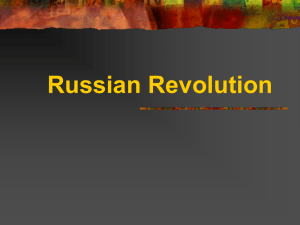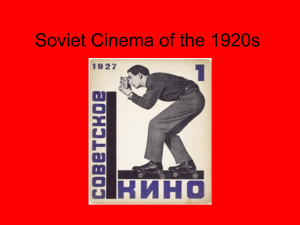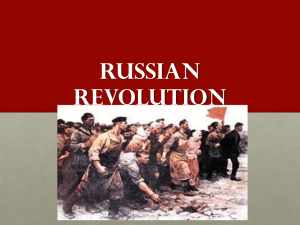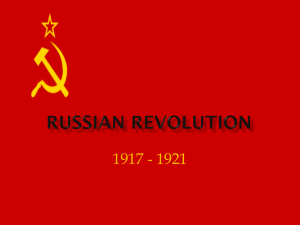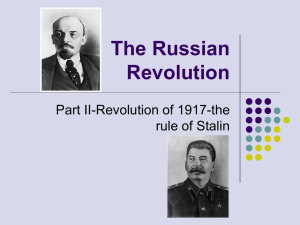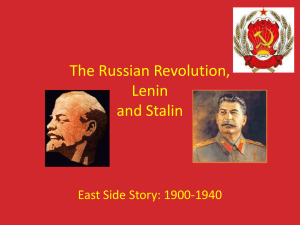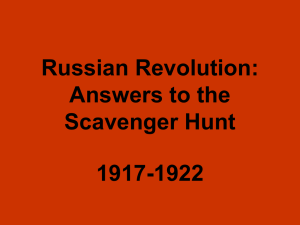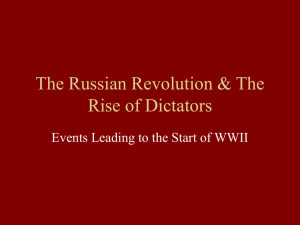File
advertisement
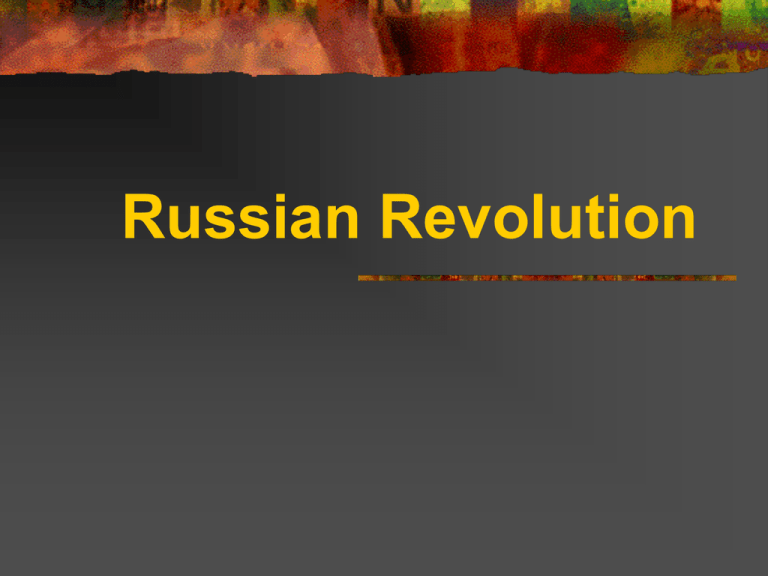
Russian Revolution Basic tenets of Marxism: *** Man is by nature good • Economic relations determine all human relations • Exploitation is an inherent failure of capitalism • Private property is evil • Capitalism produces two classes of people • Only revolution can rid society of capitalism and establish the dictatorship of the proletariat • Classlessness and statelessness will follow only after the revolution and a transition period A Look At What We Will Cover Slides 5 -20 = Background (RS Pre-WW1) Slides 21-26 = Russia in WW1 - Downfall Slides 30-35 = October / March Revolution Slides 35-47 = Bolshevik State Slides 48-52 = A Sneak Peak at Stalin Russian Government Before Revolution Monarchy: The Czar (Tsar) Until 1905 the Tsar's powers were unlimited. Russia had no constitution, no political party system to check the Tsar's power A strong secret police which terrorized the people. Called: Okhrana Royal Background Nicholas I • Created the first secret police in Russia, brutal leader, response to revolt of army officers in 1825 Czar Alexander II • He implemented important reforms, notably the abolition of serfdom, • In 1867, he sold Alaska and the Aleutian Islands to the United States. • Killed by the Revolutionary Group: The People’s Will Czar Alexander III • Alexander III's reign was during an industrial revolution in Russia . • His reign was harsh, against revolutionaries and other liberal movements. Czar Nicholas II (1894) Last Czar of Russia *** Nicholas II was a harsh and weak ruler The Russian economy was bankrupt because of the Russo-Japanese War and WWI Russia’s entry into WWI became very unpopular. Czar Nicholas II and Family *** 1903 The Social Democratic Labour Party creates sides of the Mensheviks-minority (Martov) and Bolsheviks-majority (Lenin) Iskra remained a Menshevik newspaper so Lenin had to create his own (Vperyod – “forward”) Formal split of Mensheviks and Bolsheviks as a party in 1911 Bolsheviks believed that a small group of revolutionaries could cause the revolution - masses uniting all at once was unnecessary Mensheviks focused on winning over the masses to start a revolution *** Russo-Japanese War (1904) Dispute over Manchuria with Japan Shook national confidence in their progress and rule of Czar. Loss of Russo-Japanese War This proverbial “straw that broke the camel’s back” was enough to foment allout revolutionary action *** Bloody Sunday Tsar’s troops fired on a group of protestors who were begging the Tsar for help – led by a priest – Father Gapon In all, 130 were killed and hundreds wounded Bloody Sunday (1905) *** Bloody Sunday – historical significance? It revealed how utterly incompetent the Tsarist regime was in dealing with a dissatisfied people Those who had previously supported the Tsar broke and joined revolutionary groups *** Between October 20-30th, all of Russia was on strike Considered the most effective general strike in history During this time, the very first Soviet was established in St. Pete’s October Manifesto *** October Manifesto – Tsar’s promises: Provided some civil liberties Create a DUMA – legislative assembly controlled by the moderates Between 1905 and 1917 Tsar reneged on most of his promises Tsar bought off the moderates in the Duma Tsar arrested radical opposition as terrorism grew Then the Great War broke out… Film – Russia Land of the Czars https://www.youtube.com/watch?v=1W1b6 j8U46k&list=PL9819B471D1049AE6 https://www.youtube.com/watch?v=BqxWWRcN-4 16:00 Minutes Long Rasputin Russia and World War I Russia declares war on AustriaHungary War becomes unpopular Rationing leads to starvation Nicholas II leaves St. Petersburg to war front *** Ra Ra Rasputin Won favour with Tsarina Alexandra for helping her haemophiliac child Alexis feel better Nicholas joins the losing war front in 1915 which allowed Rasputin to gain favour with Alexandra Prophesized a losing war for Russia – prophecies gained him popularity Often clashed with the Duma – Duma saw him as a threat since he was so close to the royal family 1915 the Duma was disbanded and Rasputin was in charge of the government 1916 Rasputin was assassinated Rasputin Rasputin with Admirers http://www.youtube.com/watch?v=3Zz0sHu-m7s Rasputin Death Scene Rasputin – Music Video – Bony M http://www.youtube.com/watch?v=kvDMlk3kSYg - Original Music Vid http://www.youtube.com/watch?v=VmkySNDX4dU - Vid With Lyrics and Pictures http://www.youtube.com/watch?v=3Zz0sHu-m7s - Rasputin Death Scene Mensheviks Literally means “minority” (yet were more of them) More moderate, less impatient, wanted to win over the masses Led by Julius Martov Bolsheviks Literally means “majority” Believed that a violent revolution was necessary Led by Lenin FIRST OF TWO REVOLUTIONS February-March Revolution 1917 March 12 demonstration due to hunger, a military regiment was sent to quell them (the Cossacks), they joined instead and disarmed the police Russian Army commanders suggested to Tsar Nicholas to abdicate in fears of a violent revolution (like French) The Army and the Duma convinced Nicholas that the people would no longer support him *** February-March Revolution 1917 Nicholas abdicates on March 15 and is placed under house arrest A provisional government under Alexander Kerensky is put in charge of Russia Kerensky favours a continuation of war to boost Russian nationalism Legalizes strikes Organizes a constituent assembly (to figure out a new constitution) Provisional government will have a power struggle between the Marxists and the Liberals (wanted to stop the revolution) Lacked legitimacy since it was not elected by the people *** February-March Revolution 1917 Lenin, who was in exile in Germany, was provided with safe passage from Germany to Russia in hopes that he would help stop the war on the Eastern front for Germany Lenin returns to Russia and gains more support by criticizing socialists that supported the Duma (they’re supposed to start a revolution, not maintain subordination) In April, Lenin writes the “April Theses” calls for immediate revolution Peace Seizure of aristocratic lands All power to soviets (labour movements) Seizure of factories *** Kerensky fails Russia Continues the war with a new offensive in July (Kerensky offensive) The unsuccessful offensive quickly cause dissent amongst the people Disagreement between Kerensky and Kornilov (leader of another party in power) causes Kornilov to attempt a coup using the army Kerensky turns to Lenin and his Red Guards and Soviets (workers council) to help him defend Petrograd and won Kerensky realizes the trouble he created and decides that he now needs to limit Bolshevik power Kerensky closes down Bolshevik newspapers and cuts off telephone lines Bolsheviks defeating the army won favour from the Soviets in Petrograd Government troops open fire on a worker's protest in Petrograd in July of 1917. The shootings only served to further anger the citizens of Petrograd. SECOND OF TWO REVOLUTIONS October (Bolshevik) Revolution1917 Lead by VI Lenin “Peace, Land, and Bread” Won support of people (especially peasants) *** *** October Revolution 1917 (Bolshevik) Lenin rides on the unhappiness of the people with the Duma and promises “Peace, Bread and Land!” Trotsky persuades Lenin to take over the government November 7, Lenin with his Red Guards seized the Winter Palace *** Lenin’s Immediate Policies Making good on his promise, he sanctioned peasant seizures of land, gathered grain to feed cities, and signed the treaty of Brest-Litovsk which gave up a large portion of Western Russia and 30% of Russia’s population Nationalized banks State controlled foreign trade All opposition groups made illegal Peasant seizure of lands Factories under the control of Soviets *** 1918 1918 March The Bolsheviks accept the peace of Brest-Litovsk, ending WWI with Germany. 1919-1920 -1919 White Armies (Royal and Menshevik troops) attack the Reds (Bolsheviks) from all directions. -Help sent from Western countries – leads to Stalin’s distrust of West. 1920- Reds defeat Whites Rule of Lenin 1920-1924 Economic Reforms included the New Economic Plan (NEP) -moderate mix of capitalism and socialism Political Reforms -Bolshevik party became Communist Party -Russia becomes the Union of Soviet Socialist Republics Communism A Form of Socialism Central Planning of the Economy by the State Gov’t (Communist Party) makes decisions on individual jobs and pay 1924 Lenin Dies Power Vaccuum Leon Trotsky vs. Joseph Stalin Stalin takes control Now must decide how he will maintain power Decides to create a totalitarian state Characteristics of a Totalitarian State Dictatorship- Absolute Authority Dynamic Leader- Vision for the nation State Control Over All Sectors of Society State Control Over the Individual Business, Family Life, Labor, youth groups, housing, religion, education, the arts Obedience Denies basic liberties Organized Violence Uses force to crush opposition Stalin’s Totalitarian State State Control of the Economy Police Terror Control of the individual Propaganda (socialist realism) Great Purge, crush opposition Religious Persecution 5 year plan, collective farms Molding peoples minds Education Controlled by the government

